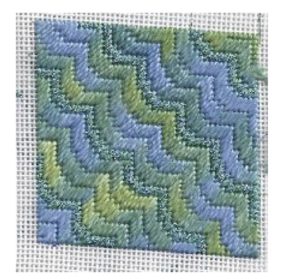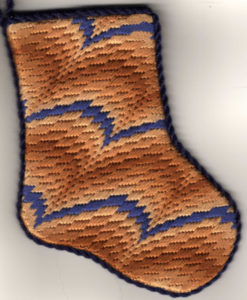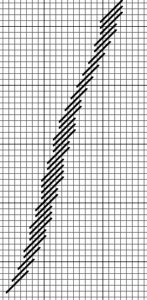
In 1977 and 1979 Karen Kuckenbecker published two pamphlets with some of the most interesting ideas I’ve ever seen in Bargello — diagonal Bargello, which she called Bargello on the Bias. The two books are worth seeking out if you love Bargello.
Diagonal Bargello is simply explained. Instead of straight stitches going between the threads, as in regular Bargello, these stitches are diagonal, going over two or more intersections. The end result as you can see from the projects pictured here, look very different.
Bargello on the Bias
This book presents almost 20 patterns for diagonal Bargello presented in hand-drawn charts. Projects made form ten of the patterns are pictured inside the front cover.
Each pattern has a name, a chart, and stitching notes. Occasional tips are in the book in boxes. The final page includes suggestions for signing your work.
Because of the limitations of space, typewriters, and pasting the patterns in, the notes cannot be extensive. This can mean that the notes often feel incomplete. The notes may suggest using an even number of shades, but there is no explanation of why. If a pattern is of interest you’ll just have to try patterns on a doodle cloth to see what works.
The patterns vary greatly in difficulty from ones that are simple line patterns with stitches of one length to patterns with stitches of several lengths and broken lines. They are not rated for difficulty, nor are they ordered in any way. To find the ones that are easy, you’ll just have to page through the book. Look carefully because it isn’t obvious where stitches of different lengths are used.

Another problem with the hand-drawn charts is that the symbols can be hard to distinguish. The same symbols are used in each chart, which is a help.
My suggestion for making sense of the charts would be to follow the bottom line which is the easiest to see because these lines are thickest. By following it you will be able to see the size of the stitches, the movement if the line, including the steps, and if the line is broken.
Even with its faults, many of which are typical of books of this period, this book is a wonderful source of pattern ideas,
Bias Bargello Reflections
This book expands on the ideas in Bargello on the Bias by introducing a modular component. The book includes thirteen modules and 22 arrangement diagrams. The idea is that you can use any module in any arrangement.
Unlike the first book, this book has information about yarn (Persian Wool). It also includes a guide to the terms used in the book and to some rules that apply when stitching the designs.
While these are diagonal Bargello patterns they are not line patterns. Instead they are for one quadrant that rotates around a center point. resulting in a diamond. Each of the patterns is divided down the center vertically so that half the module reflects the other half.
The modules come in three sizes with the size helpfully written under the name of each module. In addition a table tells you the finished size of each module on different sizes of canvas, including 18 mesh.
Following the stitch charts of the modules are the schematics of the arrangements. Schematics are not something we see often these days. Each module is drawn as a diamond. The top point of the module is indicated by a dot. The outside edge is indicated by a heavy line. Additional modules are indicated with dashed lines.
The center of the booklet has color pictures of nine finished pieces. The main part of the book includes pages on shading and tips for stitching. The bookends with a detailed section on creating your own design.
This book is far more detailed and specialized than the first book. If the medallion/diamond idea intrigues you than this book is a worthwhile investment.
Bonus Free Pattern
I have created a few diagonal Bargello patterns. Today I’m including as a bonus this simple diagonal Bargello pattern.

About Janet M Perry
Janet Perry is the Internet's leading authority on needlepoint. She designs, teaches and writes, getting raves from her fans for her innovative techniques, extensive knowledge and generous teaching style. A leading writer of stitch guides, she blogs here and lives on an island in the northeast corner of the SF Bay with her family

Leave a Reply